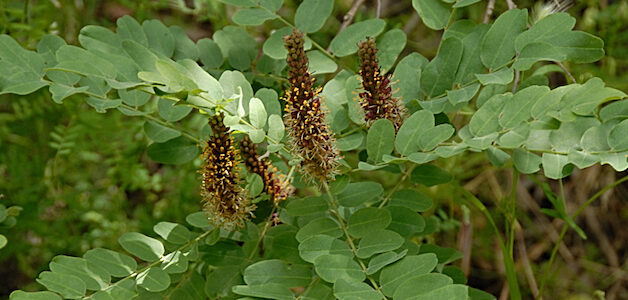
California false indigo (Amorpha californica var. californica) is a spring bloomer with handsome spikes of deep violet flowers. This deciduous shrub is classified in the pea family, though the flower looks nothing like a typical pea flower. Each floret is composed of a single reduced petal off-set by contrasting white stamens tipped with bright yellow/orange anthers. Amorpha can be seen in the wild growing in chaparral and woodland habitats in full sun, part shade, or dappled light. Typically false indigo is a 3’ – 6’ high by the same wide, though it can reach up to 10’ in height. Attractive slightly hairy oval shaped leaflets form pinnately compound leaves each tipped with a resin gland. The fruit is a tiny version of a typical legume pod containing a single seed. There are two recognized varieties of Amorpha californica, the threatened variety napensis is found only in Napa, Sonoma and Marin counties and is considered fairly threatened in its restricted native range (especially now with fires raging in areas where it is known to grow). Both varieties of Amorpha californica and its close cousin A. fruticosa (more common down south) are larval host to the California dogface butterfly, the official state butterfly.
California dogface Zerene eurydice is a ‘yellow’ from the Family Pieridae. The male has a black blob on the top side of the forewings creating the background for the yellow profile of a cartoonish dog face. The female is mostly yellow with a small black dot on the top of the forewings while the hindwing is sometimes a pale green. The dogface adult is not a picky eater and freely sips the nectar of any blooming flower within flight range. But as a caterpillar, it feeds only on the false indigo (Amorpha sp.). In the Field Guide to Butterflies of the SanFrancisco Bay and Sacramento Valley Regions the authors say the state butterfly “occurs in the North and East Bay and a few relict populations in the Sacramento Valley, where it and its host plant were probably more wide spread in riparian habitat in the past.” That was published in 2007. Currently iNaturalist shows no occurrences of Zerene eurydice in Alameda or Contra Costa Counties. Which makes sense since the shrub Amorpha californica does not show up in the Annotated Check List Of The East Bay Flora. Whether or not false indigo historically occurred in the East Bay is a question for further research. It has been pointed out that since we don’t have the California dogface butterfly over here in the East Bay – you are unlikely to attract the insect to your garden.
These days the best chance of seeing this intriguing plant locally in the wild is in the North Bay. There, it can be seen growing along trails on Mt. Tam and Mt Burdell. A few years back on a summer day while hiking at Mt. Burdell I found myself standing and staring dumbly into the understory trying to figure out what I was seeing. Finally the light bulb brightened and I realized was looking at a stand of false indigo in fruit. I need to remember to get back there in late spring to see the wild bloom and find out if the state butterfly knows about the spot.
Horticultural uses of the plant are not limited to butterfly gardening. Amorpha is an interesting, unusual addition to dappled or part shade in an oak woodland garden, or as a back of the border planting or an informal hedge. Plant in soil with moderate drainage. If you have clay try amending with some compost. You will have to water to establish but once the plant makes itself at home, water only once per month in the dry months until it drops its leaves. Once your false indigo has gone dormant there is no need to water.
Currently at Oaktown Native Plant Nursery we have a nice crop of the more common Amorpha californica var. californica grown from commercially available seed.
References include: Calscape, Calflora, iNaturalist, Field Guide to Butterflies of the SanFrancisco Bay and Sacramento Valley Regions by A.M. Shapiro and T.D. Manolis, Annotated Check List Of The East Bay Flora by B. Ertter and Lech Naumovich
Photo credit D.E. Warenycia